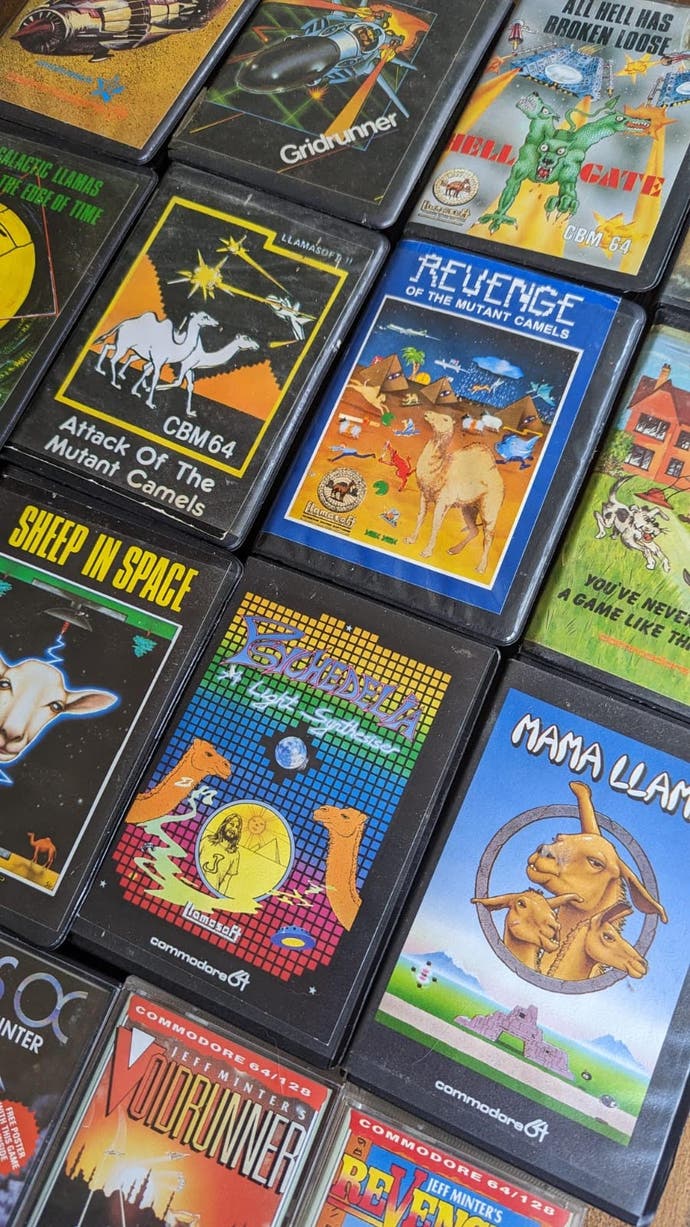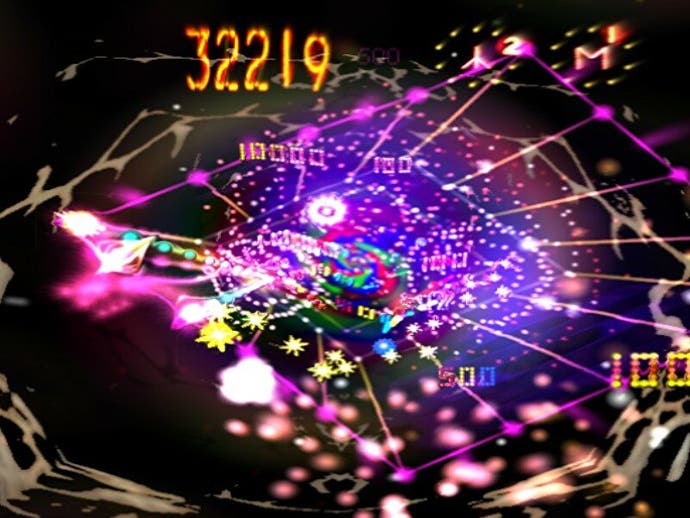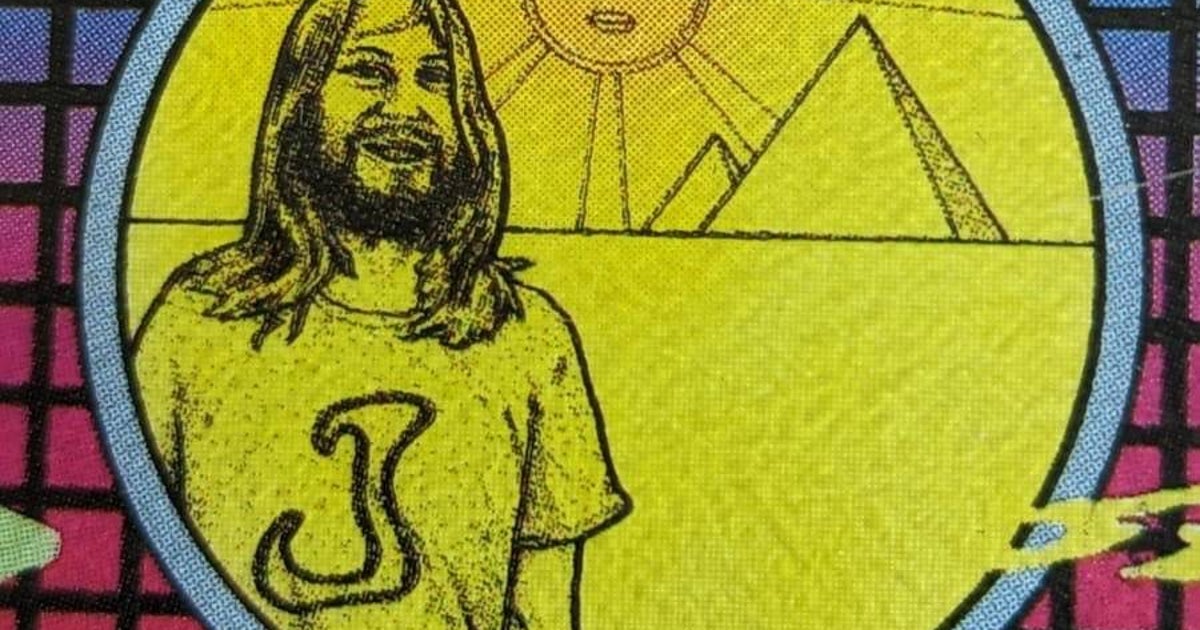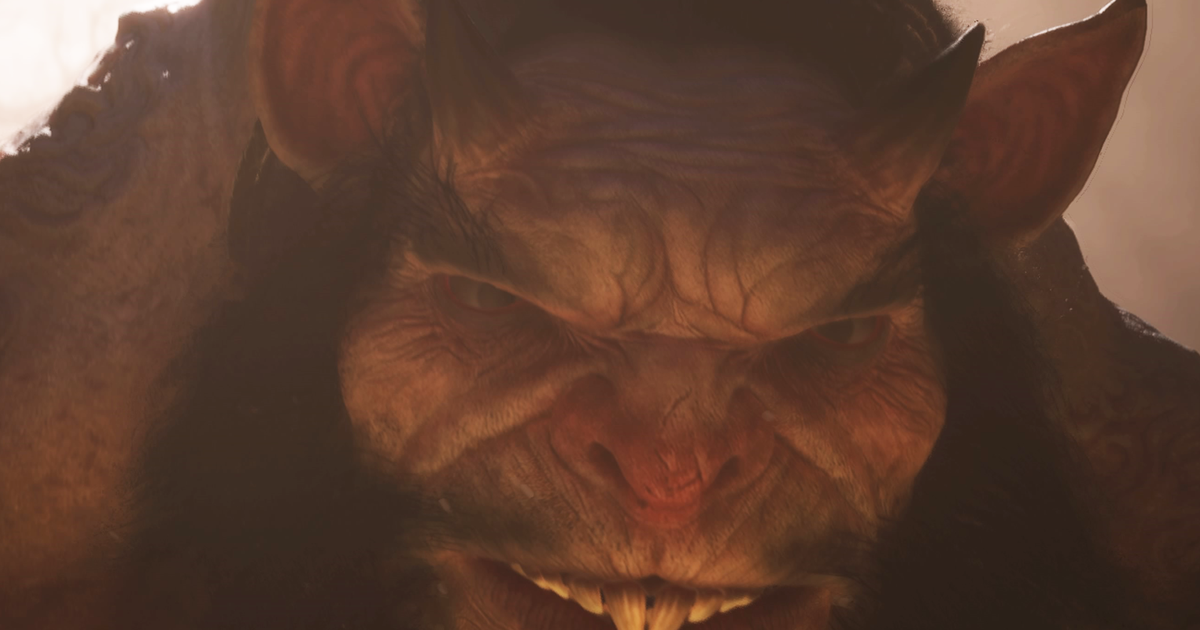Jeff Minter is a genius. I don’t know how else to describe a developer who’s been dabbling in far out magic since 1982 and conjuring up games that have always been pushing at the more extreme edges of the form: fizzing psychedelic light shows backed up by tightly engineered arcade chops, and experiences that dizzy you with their intensity and verve. Somehow his games haven’t lost any of their dazzle over his 40 year plus career, all of which to me makes him something of a hero to me.
Excuse the hyperbole, but I don’t mind admitting that I’m a bit of a Minter fan. He’s an exceptional engineer and a proper eccentric to boot, a fine combination that makes for games with an abundance of personality. In the noughties, when I didn’t do much more than read and re-read old Edge magazines and was often given to strange notions, I was convinced the all-timers had surnames beginning with M; there was Shigeru Miyamoto, Peter Molyneux, Tetsuya Mizuguchi and then finally Minter himself, the mad professor amidst those greats.
I mention this because I’ve had a mental checklist I’ve been working through over the years, and I’ve been lucky enough to tick off all those luminaries who lit a spark in my Edge-obsessed days. So when the opportunity to interview Jeff came up as part of the run-up to Akka Arrh’s release – a fascinating revival of a 1982 Atari arcade game that never passed its field test, and now finished up with typically exuberant Llamasoft flourish by Minter and his partner Ivan ‘Giles’ Zorzin – I wanted to do it properly. In his adopted hometown in west Wales, and over a pint and a curry.
Jeff and Giles live together on a busy little farmyard that’s served as Llamasoft’s HQ for well over a decade, the grounds nestled within the beauty of west Wales’ countryside, the house a chaos of hardware and the fields beyond home to their beloved sheep. We meet in the nearby town of Carmarthen and convene in the Ginger curry house, a restaurant so fundamental to Llamasoft’s process that it gets a special mention in the credits of Akka Arrh. Even as we take our seats at 6pm there’s a buzz to the place as it slowly fills up, and there’s a queue forming steadily outside for what’s clearly a local favourite. When it comes to ordering Jeff goes for the chicken jalfrezi, while I refrain from my usual lamb-laced laal maas out of respect (“it’d be like eating puppies!” he exclaims when I tell him of my sacrifice).
We chatted for a couple of hours and were joined by fellow nerd Tony Coles, who helped provide some amazing technical context for our conversation. The interview that follows is edited down for clarity (you don’t want to hear the clink of cutlery or me telling everyone how much I’m enjoying the garlic naan) and we spoke about plenty more besides – like how Jeff had just finished his second playthrough of Cyberpunk, while the pair had just completed Manifold Garden. I loved how Jeff spoke about them all with the same wide-eyed wonder he would have had when videogames changed his world upon first encountering them, way back in 1970s Basingstoke when he played Pong on his brother’s bright orange Binatone machine.
What was it about video games that made you fall in love with them?
Jeff Minter: The whole idea was fascinating. TVs had been things that you passively watched, so the idea that something could appear on your TV that you could actually control was amazingly novel. I mean, I can remember when I first started learning to program on the Commodore PET – just the act of typing on a keyboard and seeing letters appear on a TV was quite remarkable, it was something we’d never seen before.
I was aware of arcade games and I’d see them in arcades, obviously – but they were detached in the same way that maybe a pinball machine is detached. You can understand the pinball machine, it’s fun to play with, but you’d ever think that maybe one day I’ll sit down and make a pinball machine. That’s something that is made by wizards somewhere else!

The thing which turned me on really was seeing this guy playing this game on a machine in college and saying that he’d put it in there himself – and the idea that you could actually learn enough to put your own game into one of these things and play your own game. That sounds bloody interesting. I didn’t realise I could be a wizard just yet, but there was the possibility!
I’d wandered through education for most of my life, half-engaged with it, but nothing really got my enthusiasm the way that coding did. Nothing bit as hard as that. Once I understood what it was I had to do I was up early every morning and I’d ride my bicycle into Sixth Form College early to get on the computers as soon as possible. I’d get in before anybody else and then stay late. My parents couldn’t believe it because I was always reluctant to go to school, and now I was getting up early in the morning to go to Sixth Form College. What the fuck is going on there then?
What was it you loved about coding?
Jeff Minter: It’s being a wizard – the fact that you can create stuff by speaking the words of power! It’s wonderful! It’s the most purely creative thing I’ve encountered, ever. If you can think of it, you can make it!
Some people pick up a guitar at that age or play the piano – with you it was the Commodore PET.
Jeff Minter: I’m learning to play a bit of guitar now – there’s a lovely feeling when you start and feel like you can do a couple of little things here and there, then you can see where you can move forward with this thing. With coding I was able to pick it up straight away, and it was something I wasn’t too bad at – and every moment I spent doing it the creative possibilities were expanding and expanding, limited only by the machines we were on. It was amazing!
The way I always describe it is, imagine if you lived in a world where there was no music and then suddenly you’re at sixth form college and somebody discovers music. And you could make it yourself! It was that same fundamental level of discovery. It hadn’t existed when I was in ordinary school – it just came into existence when I was in sixth form. And then within a few years, it was a massive multi billion dollar industry. What the fuck? It was amazing to see that whole progression through from nothing!

I wanted to talk about your work with lightsynths. Where did that begin?
Jeff Minter: When I was 11 years old I used to listen to Dark Side of the Moon and in my head I’d see these geometric shapes of all different sizes. I always thought you’d be able to buy an instrument that’d let you play those shapes and get them out there, but obviously no-one did so I tried to do it myself. That was where I started experimenting with things like Psychedelia in 1984 – that evolved into Colorspace and then Tripportron, then there was VLM2 which was the one in the in the Nuon, VLM3 was for things like texture generators for the Unity game that was supposed to come out of the GameCube. That morphed into what became the neon light synth which is built into all the Xbox 360s – which is absolutely the most widely consumed bit of Llamasoft software! It’s a shame we could ever nail down Microsoft to do a royalty deal on that one, because even if we got 1p a unit we would have been fine!
It’s the other half of my career, really. People will think of the games, but really the light synth is just as much a part of my career. I kind of feel that now it’s all coming together – my style has turned into these games which take place in a light synth environment that’s very abstract. And I honestly think the best thing we’ve ever made is Space Giraffe. Absolutely the best thing we’ve ever made is Space Giraffe.
Ah, Space Giraffe! Of all the games Minter’s made since he started back in 1982 it’s perhaps Tempest 2000 that’s his most famous, but it’s Space Giraffe that’s his most notorious. It’s a willfully out there thing where the intensity of the visual effects are baked into the difficulty of the game, and where the lightsynth is pushed to extremes. It’s bewildering, but once you get your head into its own peculiar zone it’s utterly beautiful too.
What is it that makes Space Giraffe so special for you?
Jeff Minter: It was pushing in a different direction. It was trying these things like let’s overload the player deliberately and see if we can force their brain into a new space. And if people bore with it and went with it they would find themselves in a new space. It was transcendental. Some people couldn’t be arsed to push through and just decided to throw it away – publicly quite vocally – and I regret that, because I think it set me back in my career a bit.
It felt like your most high profile game because Microsoft put a bit of weight behind it.
Jeff Minter: What actually happened was we were exclusive on the Xbox at the time and before the thing actually launched we had the official Xbox magazine kicking it in the head and giving it 2/10, saying it wasn’t worth anything! That person later on went on to write books about reviewing video games – one of the things he said was you should never review a game if you don’t understand it. And you should never review a game if you don’t complete it. And they never scratched the surface of Space Giraffe! So it’s fine to give that advice to other people, but as to adhering to it himself… No!

So if Space Giraffe is your best game, what’s your worst?
Jeff Minter: Obviously some of the really early stuff is terrible! Some of the early Vic 20 things like Rat Man – I was a kid! I learned my trade. In terms of stuff I made once I knew what I was doing – I’d say maybe Mama Llama on the C64 was too experimental. I’d grown too comfortable with the idea of you could do anything you want. I still think it’s an interesting design and I don’t think it’s terrible, but I think it needs more work. It could have been tuned better.
Revisiting and playing again Defender 2000 on the Jaguar – it wasn’t entirely my fault. When I made Tempest 2000 I was contracted to Atari, and when I made Defender 2000 I was an employee of Atari. I think they felt like they could lean on me a lot more to push it in the directions they wanted it to go.
Defender is a game where the graphics are quite small, the backgrounds are quite dark – it’s very obvious, there’s a lot of stuff going on but you can pick out what’s going on against that background. First it was going to be a cartridge game, then they wanted to do it on the CD-ROM and when they decided they wanted to do it on CD-ROM they decided they wanted multiple layers of parallax background scrolling and it didn’t really need that.
The direction I would have taken it would have been less stuff in the background, smaller objects but with more effects. We ended up with this thing where it had to scroll vertically in order to encompass the entire playing area, and the ship was too big for the screen. I made the best I could of it, and I’m not saying it’s bad but it’s not the game I would have wanted to make if I’d been given my druthers. It made me realise again that I don’t really like working for a company where they can lean on you or push you in a direction where you don’t really want to go.
Minter’s struggles with Atari in the late 90s saw him move on from the company – which, of course, is entirely different to the Atari that exists today and seems to have a surer sense of its history thanks to projects such as Atari 50: The Anniversary Celebration and Akka Arrh – and onto VM Labs, an ambitious project in Silicon Valley that predated the PlayStation 2 by finding a common ground between media players and game consoles by looking to place a Nuon chip in every DVD player. It’s a project that ultimately failed, but not before enabling Minter another crack at Tempest with the outrageously gorgeous Tempest 3000.
You’ve been an indie for 40 years, pretty much. Were there many points where you’ve been tempted by a salary?
Jeff Minter: At the time when Atari died Activision was sniffing around. Do I go this way or do I go that way? And that way was the guys at VM labs, my friends who were doing something really interesting. It might not succeed – it didn’t succeed at the end of the day – but it was interesting work. It was either that or move to LA and come part of Activision who were in the process of becoming this mega machine. I’d much rather work with my friends, and if it doesn’t work, it doesn’t work.
We could have had Jeff Minter’s Call of Duty.
Jeff Minter: We could have! Call of Llama…I think the older I get, though, the less I give a shit really. I just want to carry on doing the stuff I want to do. Obviously, I’ve got to care to a certain extent with the fucking energy bills now double what they were, but really I’m trying to get through to my pension, if I live that long.
You don’t seem to have lost any of your passion, though.
Jeff Minter: I just really wish I had one big success so I could carry on making games the rest of my life and just give them away. Because the pleasure is in the act of creation.
I hate the commercial side of it, but I love the creative side. That’s why I’m quite pleased if I could do something for someone like Atari where all I’m left with is the creative side and they can worry about making the money out of it. I hate money. I hate having to grub around for money. The older I get the less patience I’ve got with it as well. We’ve only got a finite number of years on this planet, and I don’t want to spend it all grubbing around for dollars here and dollars there. For fuck sake, life’s too short!
So how many games have you got left in you?
Jeff Minter: For me retirement would only really be about not having to worry about money coming in so I could just make more games. I’ll keep making games until they plant me. It’s like, if you know how to play the guitar you don’t stop playing when you get to 65 – it’s something you know how to do, it gives you pleasure and you do it! It’s exactly what I’ll be doing until I’m incapable – maybe my brain will rot away, I don’t fucking know!
Giles: When you’re into computing or hardware, the problem is it’s like an illness – it’s something that you do because you can’t stop doing it. There’s always a new idea, something you haven’t tried, something you haven’t done. You can’t stop!
Jeff Minter: I’ve measured my entire life in projects rather than years – that’s when I was doing Defender, that’s when I was doing Tempest, that’s when I was doing Revenge of the Mutant Camels. You never stop. There’s always something in the back of your mind.
When you first discovered games did you ever wonder what they’d look like in 40 years time? I guess another way to ask that is what are the moments over the last 40 years that have blown your mind?
Jeff Minter: Real VR, as opposed to the clunky VR we had back in 1990 – which was interesting, but it was hella clunky. Being able to play at 90 frames a second, and where I could turn my head and it’s all still there – that was good! But there are other milestones – being able to use chunky 256 colour for the first time on the Konix and escaping a palette that was only 16 entries. The Commodore 64 palette was rubbish, let’s face it – on the 8-bit Atari you had a decent selection of colours, and I’ve always loved me colours…
But since then limitations have fallen away. Limitations are interesting because they force creativity in a certain direction, and that’s why there’s a demoscene. It’s interesting and fascinating to work within those constraints. So in a way it is a good thing, and people should take inspiration from that – you might be one person and think you can’t make games, but look at the tools that are there and work within the constraints of that and your own team. You can still make great stuff. It shouldn’t put you off.
What are some of the games of the last five years that have blown your mind?
Jeff Minter: Things like No Man’s Sky – a lot of people didn’t like it when it first came out. I could see the potential even in the early days – I spent a long time just wandering around and just loving the fact that I could be in this Roger Dean sci-fi universe – this is fantastic! How amazing is that? They stuck with it through all the shit, which I can emphasise with as I went through that with Space Giraffe.
We should talk about Akka Arrh as that’s what we’re here for! Before that, though – if you had your pick of any other game in the back catalogue what would be it be?
Jeff Minter: There’s a few interesting things in there, but I don’t want to talk about it so much because I think Atari want to see how this goes down first. I liked the idea of doing Akka Arrh because the backstory was so interesting – the fact it was exclusive to this one collector who’d hoarded the ROMs to himself, and then one of his technicians liberated them. When you look at the game you can understand why it didn’t pass its field test – it was interesting but flawed.
When Atari presented me the back catalogue that was in there – and it was a rod for my own back, because it was starting from a flawed beginning. There were some good ideas that maybe I could develop. It was interesting but hard – unlike something like Robotron where you got your arse kicked and went back, this wasn’t compelling enough. It was an interesting challenge, and one I sometimes regretted taking on – there were times when I was like fuck me I’m never going to get this to work.
Giles: But you always despair!
Jeff Minter: That’s the thing about being a proper game designer – you can set out and no matter what goes on, you encounter hardship but you know you’ve made this journey a million times before, you know you can make it to the other side, you know the day will dawn where you’ll find that one thing that works and you’ve just got to fucking stick to it. I get frustrated with people saying they started making this game and the moment an obstacle comes up they throw their arms up and say I’m not going to do this anymore. The number one skill in making a game is completion! Bring the thing through – make the thing!
The plates are cleared away and the bill comes, so I wrap up by blowing smoke up Minter’s arse with a comparison I’ve always had in my mind between him and Aphex Twin, another eccentric enthusiast who’s dedicated their lives to their own brand of out there art. “He still owes me a fiver!” says Minter, who’s also a massive fan. “He was interviewed in the NME years ago, back in the 90s sometime, and was asked what his favourite video game was – and he said it was Llamatron! But I don’t remember ever having seen a sales registration from a Richard D. James…”
They say never meet your heroes, but after an evening in the presence of Jeff and Giles I’m energised by their seemingly endless passion for what they do, and grateful for the level of craft they bring to their projects. Akka Arrh’s another fine Llamasoft entry – and you’ll find a review of it on Eurogamer next week – and it’ll be far from their last. There’s a project they keep returning to across the night, and one they’re clearly very keen to do. “We’ve got a multiuser lightsynth in VR,” says Jeff. “And it’s something else.”
“The ultimate goal is to do Space Giraffe 2 in VR and its environment will effectively be VLM4, that multi-user lightsynth. After that, it’s not as if I’m going to retire but I can collapse into an exhausted heap at the end of my career and think thank fuck I got there.” Thank fuck I got to finally meet Minter, too, a living legend responsible for over 40 years of psychedelic genius.
Thanks to Jessica Timms for helping set up the interview, and to Tony Coles for being a fantastic companion for the evening.



